Compact Four-Port MIMO Antenna Using Dual-Polarized Patch and Defected Ground Structure for IoT Devices
Abstract
1. Introduction
2. The Dual-Polarized Patch Antenna
3. The Four-Port MIMO Antenna Without a Decoupling Network
4. The Four-Port MIMO Antenna with a Decoupling Network
4.1. H-Plane Decoupling
4.2. E-Plane Decoupling
4.3. Final Realization of the Four-Port MIMO Antenna
5. A Multi-Port MIMO Array
6. Measurements
7. Conclusions
Author Contributions
Funding
Institutional Review Board Statement
Informed Consent Statement
Data Availability Statement
Conflicts of Interest
References
- Jensen, M.; Wallace, J. A review of antennas and propagation for MIMO wireless communications. IEEE Trans. Antennas Propag. 2004, 52, 2810–2824. [Google Scholar] [CrossRef]
- Xia, R.L.; Qu, S.W.; Li, P.F.; Jiang, Q.; Nie, Z.P. An Efficient Decoupling Feeding Network for Microstrip Antenna Array. IEEE Antennas Wirel. Propag. Lett. 2015, 14, 871–874. [Google Scholar] [CrossRef]
- Li, M.; Jiang, L.; Yeung, K.L. Novel and Efficient Parasitic Decoupling Network for Closely Coupled Antennas. IEEE Trans. Antennas Propag. 2019, 67, 3574–3585. [Google Scholar] [CrossRef]
- Li, M.; Zhang, Y.; Wu, D.; Yeung, K.L.; Jiang, L.; Murch, R. Decoupling and Matching Network for Dual-Band MIMO Antennas. IEEE Trans. Antennas Propag. 2022, 70, 1764–1775. [Google Scholar] [CrossRef]
- Gao, D.; Cao, Z.X.; Fu, S.D.; Quan, X.; Chen, P. A Novel Slot-Array Defected Ground Structure for Decoupling Microstrip Antenna Array. IEEE Trans. Antennas Propag. 2020, 68, 7027–7038. [Google Scholar] [CrossRef]
- Hwangbo, S.; Yang, H.Y.; Yoon, Y.K. Mutual Coupling Reduction Using Micromachined Complementary Meander-Line Slots for a Patch Array Antenna. IEEE Antennas Wirel. Propag. Lett. 2017, 16, 1667–1670. [Google Scholar] [CrossRef]
- Qian, B.; Chen, X.; Zhao, L.; Chen, J.; Kishk, A.A. Reduced Cross-Polarization and Backside Radiations for Rectangular Microstrip Antennas Using Defected Ground Structure Combined With Decoupling Structure. IEEE Antennas Wirel. Propag. Lett. 2023, 22, 517–521. [Google Scholar] [CrossRef]
- Yang, X.; Liu, Y.; Xu, Y.X.; Gong, S.x. Isolation Enhancement in Patch Antenna Array With Fractal UC-EBG Structure and Cross Slot. IEEE Antennas Wirel. Propag. Lett. 2017, 16, 2175–2178. [Google Scholar] [CrossRef]
- Wei, K.; Li, J.Y.; Wang, L.; Xing, Z.J.; Xu, R. Mutual Coupling Reduction by Novel Fractal Defected Ground Structure Bandgap Filter. IEEE Trans. Antennas Propag. 2016, 64, 4328–4335. [Google Scholar] [CrossRef]
- Assimonis, S.D.; Yioultsis, T.V.; Antonopoulos, C.S. Design and Optimization of Uniplanar EBG Structures for Low Profile Antenna Applications and Mutual Coupling Reduction. IEEE Trans. Antennas Propag. 2012, 60, 4944–4949. [Google Scholar] [CrossRef]
- Tran, H.H.; Nguyen-Trong, N. Performance Enhancement of MIMO Patch Antenna Using Parasitic Elements. IEEE Access 2021, 9, 30011–30016. [Google Scholar] [CrossRef]
- Pei, T.; Zhu, L.; Wang, J.; Wu, W. A Low-Profile Decoupling Structure for Mutual Coupling Suppression in MIMO Patch Antenna. IEEE Trans. Antennas Propag. 2021, 69, 6145–6153. [Google Scholar] [CrossRef]
- Qi, H.; Yin, X.; Liu, L.; Rong, Y.; Qian, H. Improving Isolation Between Closely Spaced Patch Antennas Using Interdigital Lines. IEEE Antennas Wirel. Propag. Lett. 2016, 15, 286–289. [Google Scholar] [CrossRef]
- Li, M.; Zhong, B.G.; Cheung, S.W. Isolation Enhancement for MIMO Patch Antennas Using Near-Field Resonators as Coupling-Mode Transducers. IEEE Trans. Antennas Propag. 2019, 67, 755–764. [Google Scholar] [CrossRef]
- Tang, M.C.; Chen, Z.; Wang, H.; Li, M.; Luo, B.; Wang, J.; Shi, Z.; Ziolkowski, R.W. Mutual Coupling Reduction Using Meta-Structures for Wideband, Dual-Polarized, and High-Density Patch Arrays. IEEE Trans. Antennas Propag. 2017, 65, 3986–3998. [Google Scholar] [CrossRef]
- Wong, K.L.; Hong, S.E.; Tseng, Y.S.; Li, W.Y. Low-Profile Compact 8-Port MIMO Antenna Module and Its 1 × 2 Array for 6G 16 × 8 Device MIMO Application. IEEE Access 2023, 11, 137011–137024. [Google Scholar] [CrossRef]
- Wong, K.L.; Huang, Y.Y.; Li, W.Y. Compact 8-Port 2 × 2 Array Based on Dual-Polarized Patch Antennas With Modified Cavity Field Distribution for Enhanced Port Isolation for 5G IoT Device MIMO Antennas. IEEE Access 2024, 12, 79311–79326. [Google Scholar] [CrossRef]
- Wong, K.L.; Wei, T.C.; Tseng, Y.S.; Li, W.Y. Compact 2 × 2 Dual-Polarized Patch Antenna Array Transmitting Eight Uncorrelated Waves for the WiFi-6E MIMO Access Point Featuring Eight Spatial Streams. IEEE Access 2024, 12, 36793–36809. [Google Scholar] [CrossRef]
- Zhang, Y.M.; Zhang, S.; Li, J.L.; Pedersen, G.F. A Transmission-Line-Based Decoupling Method for MIMO Antenna Arrays. IEEE Trans. Antennas Propag. 2019, 67, 3117–3131. [Google Scholar] [CrossRef]
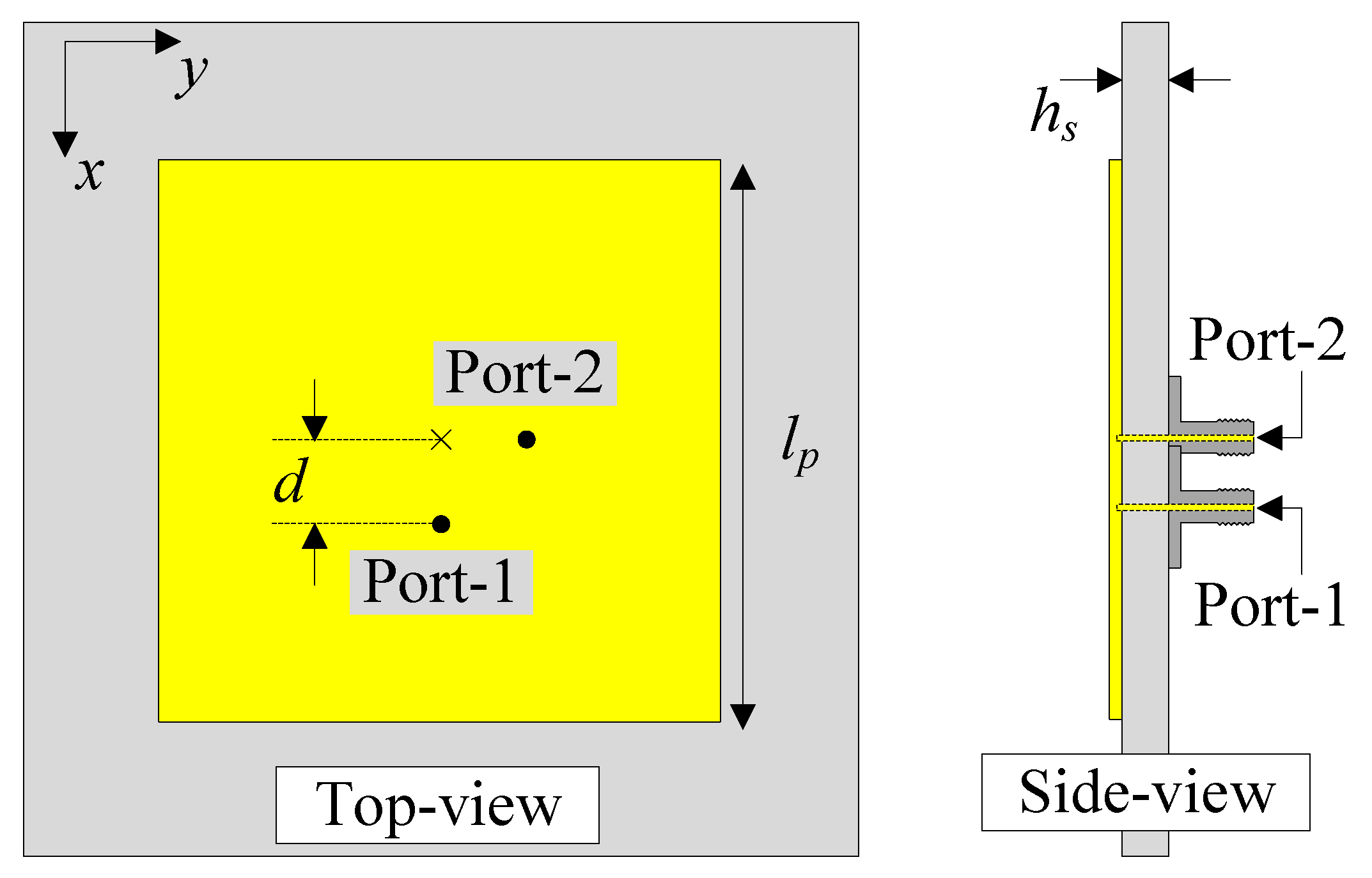

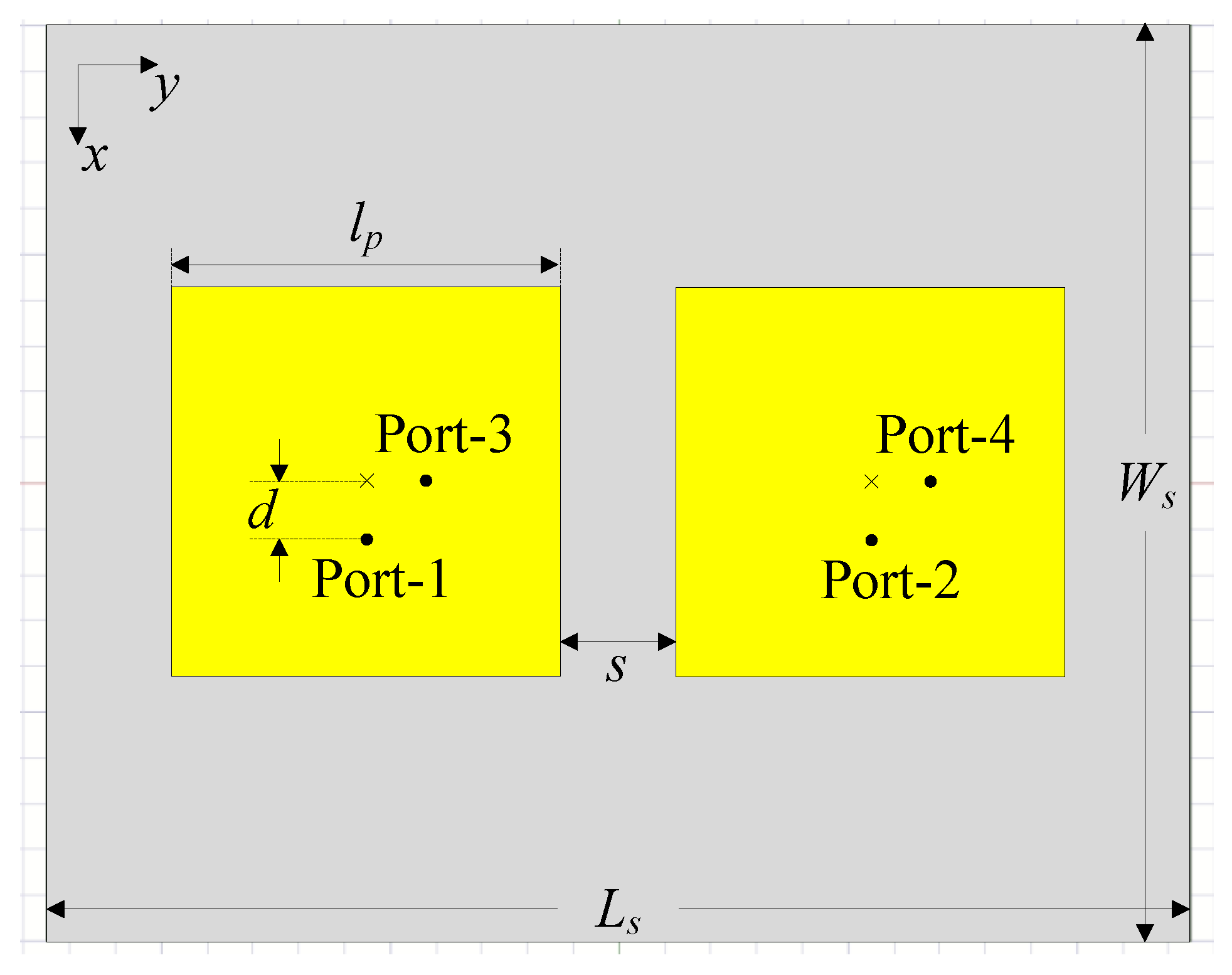
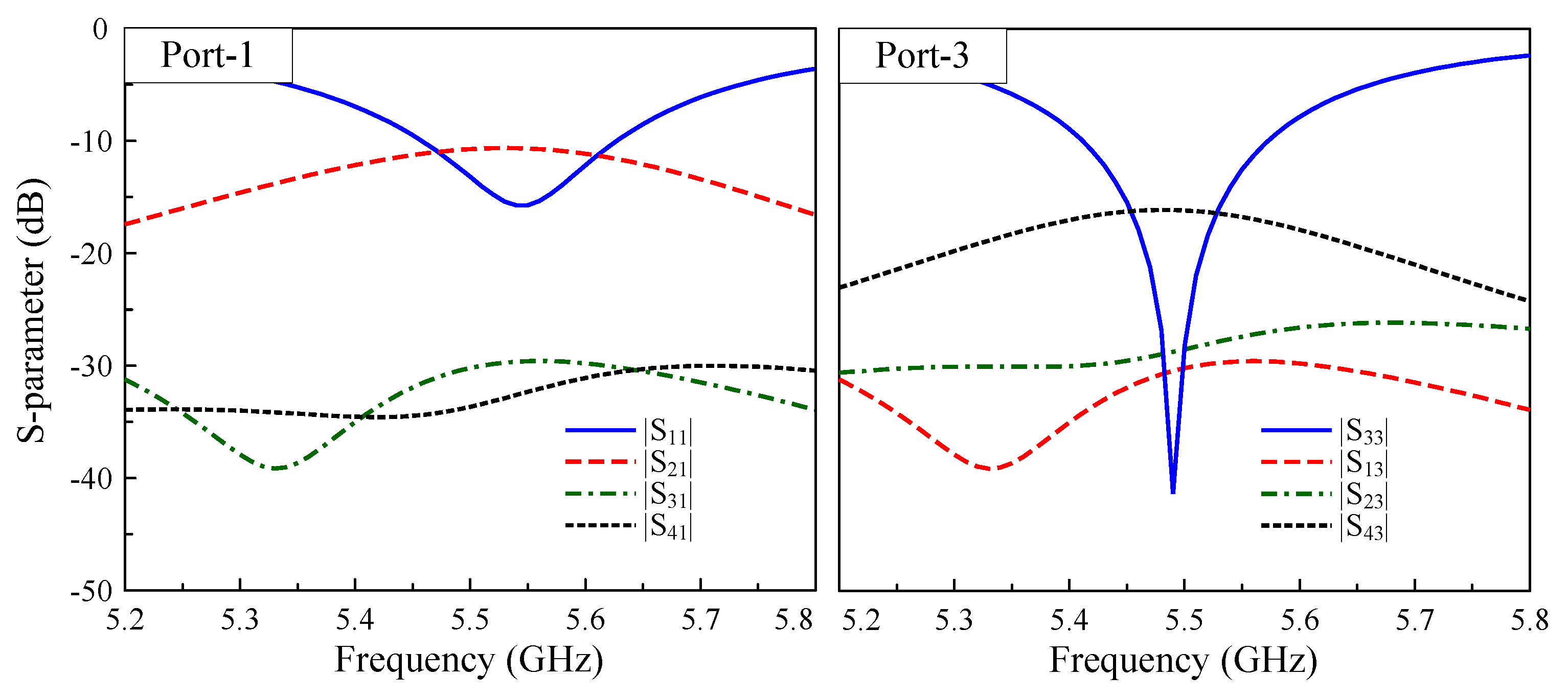
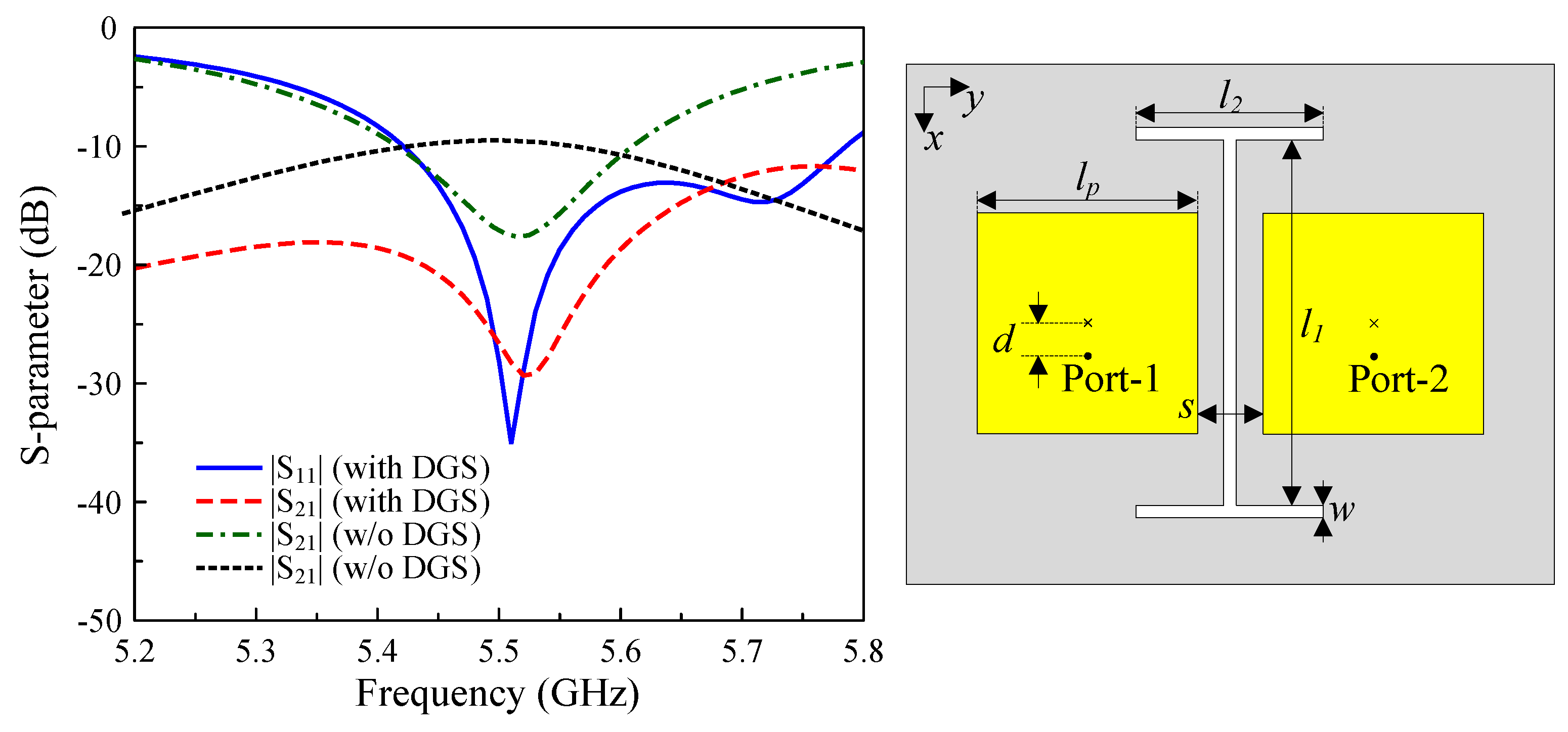
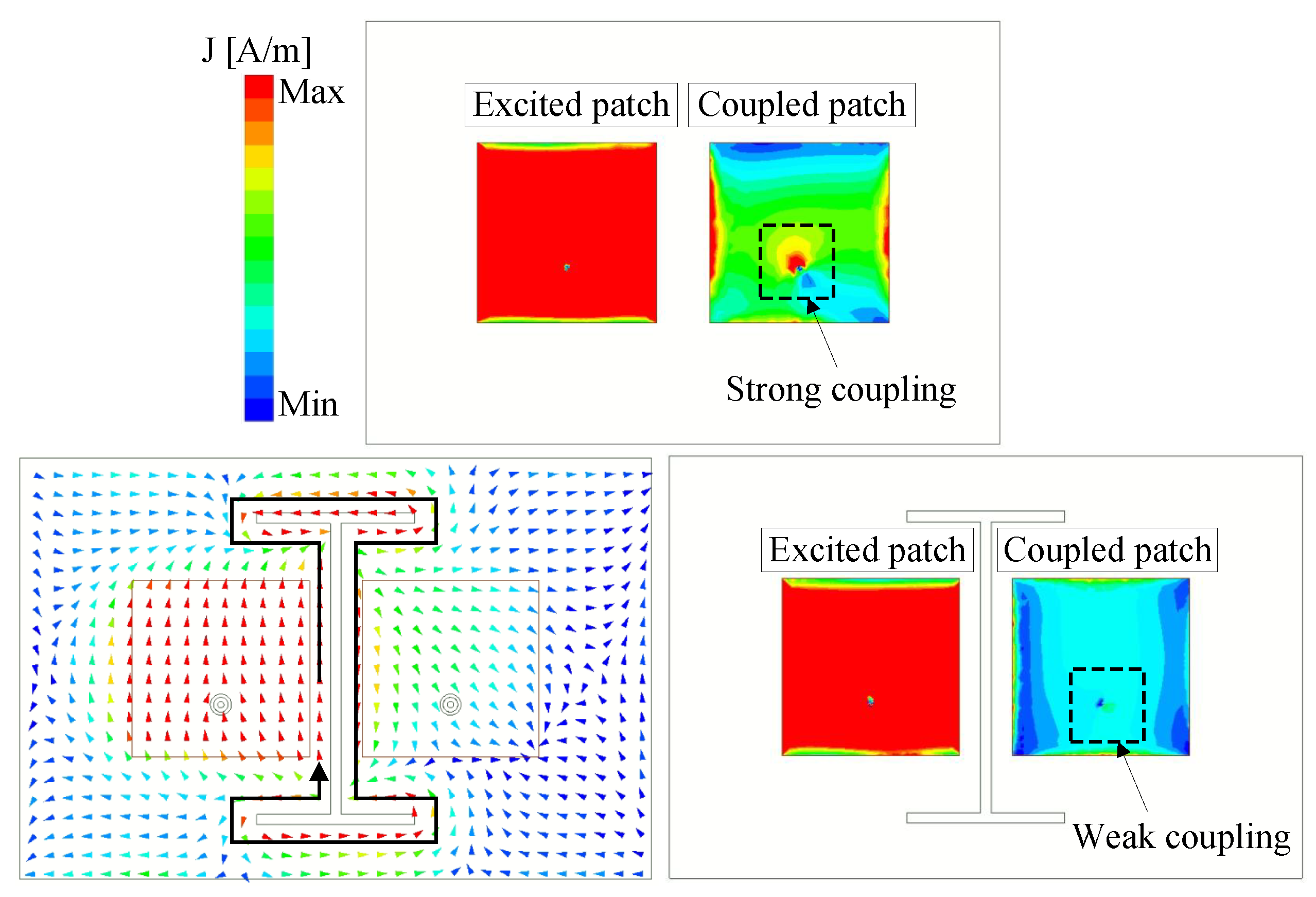
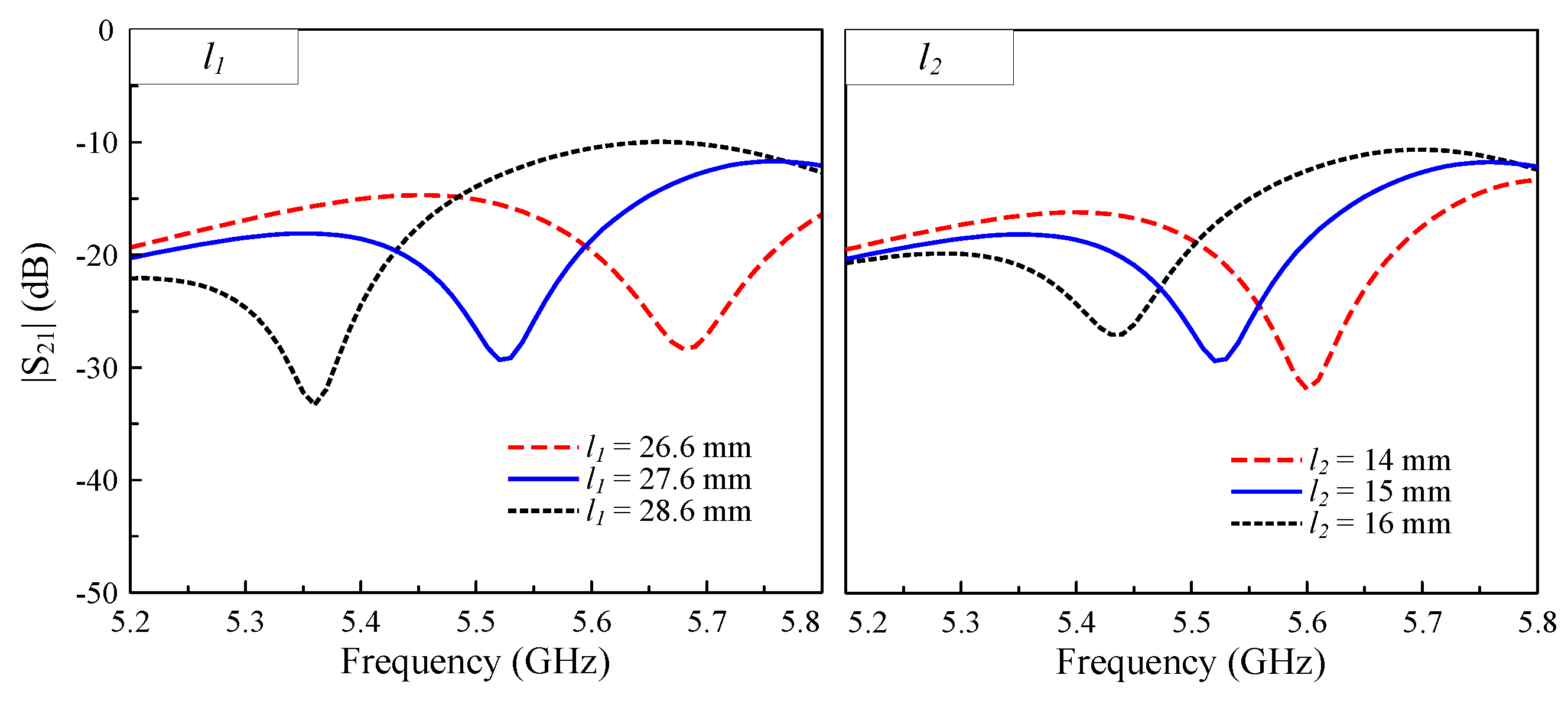
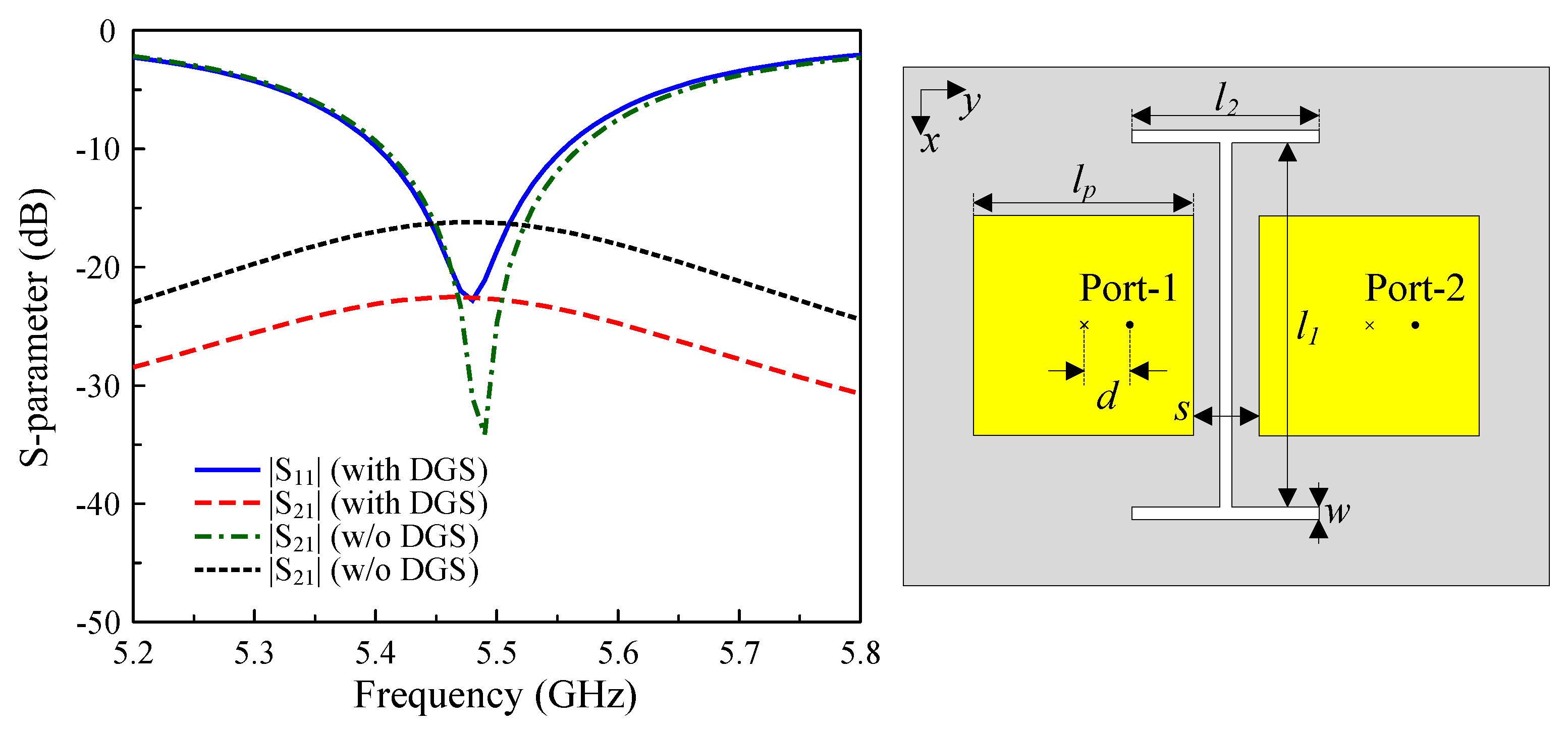
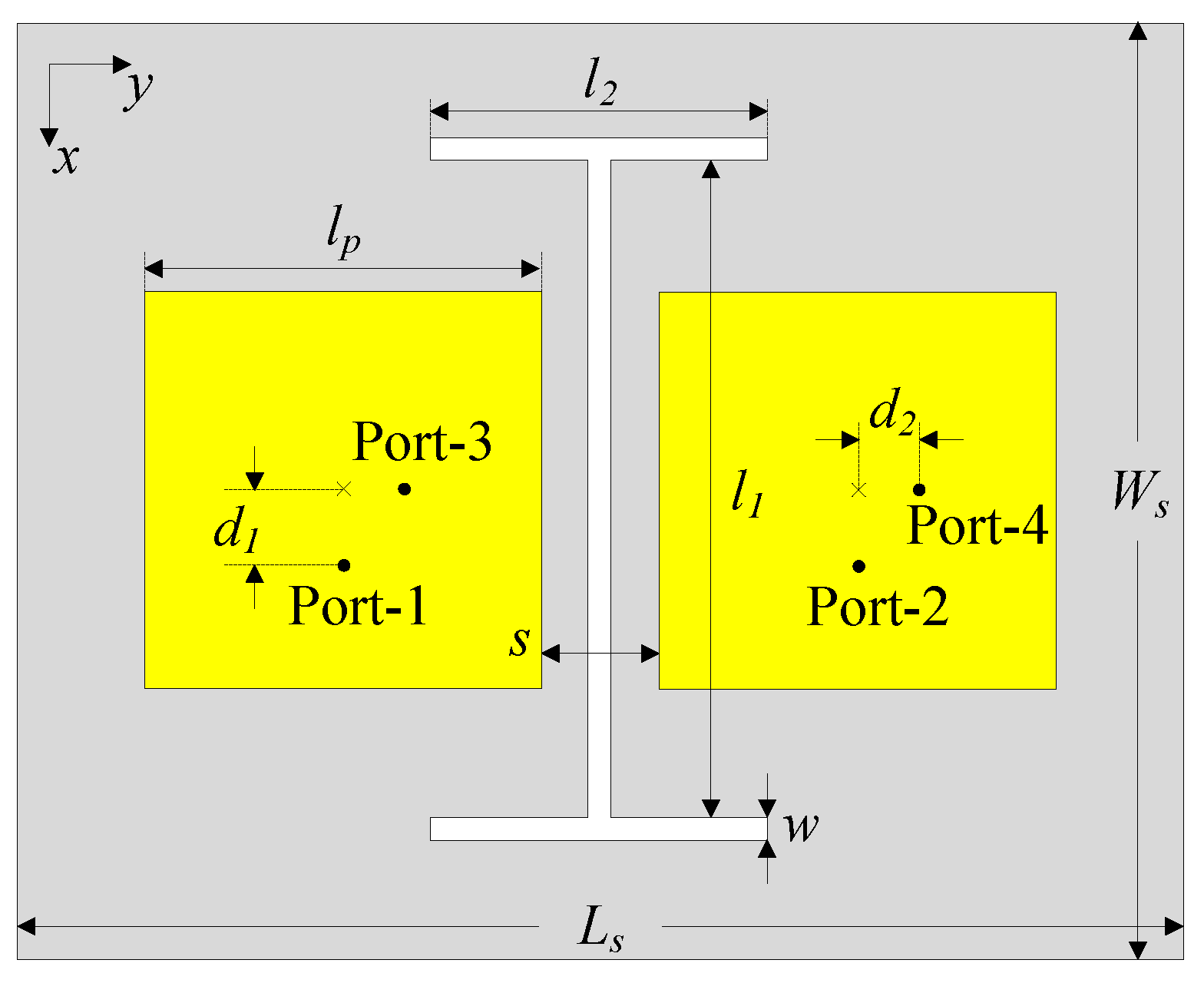
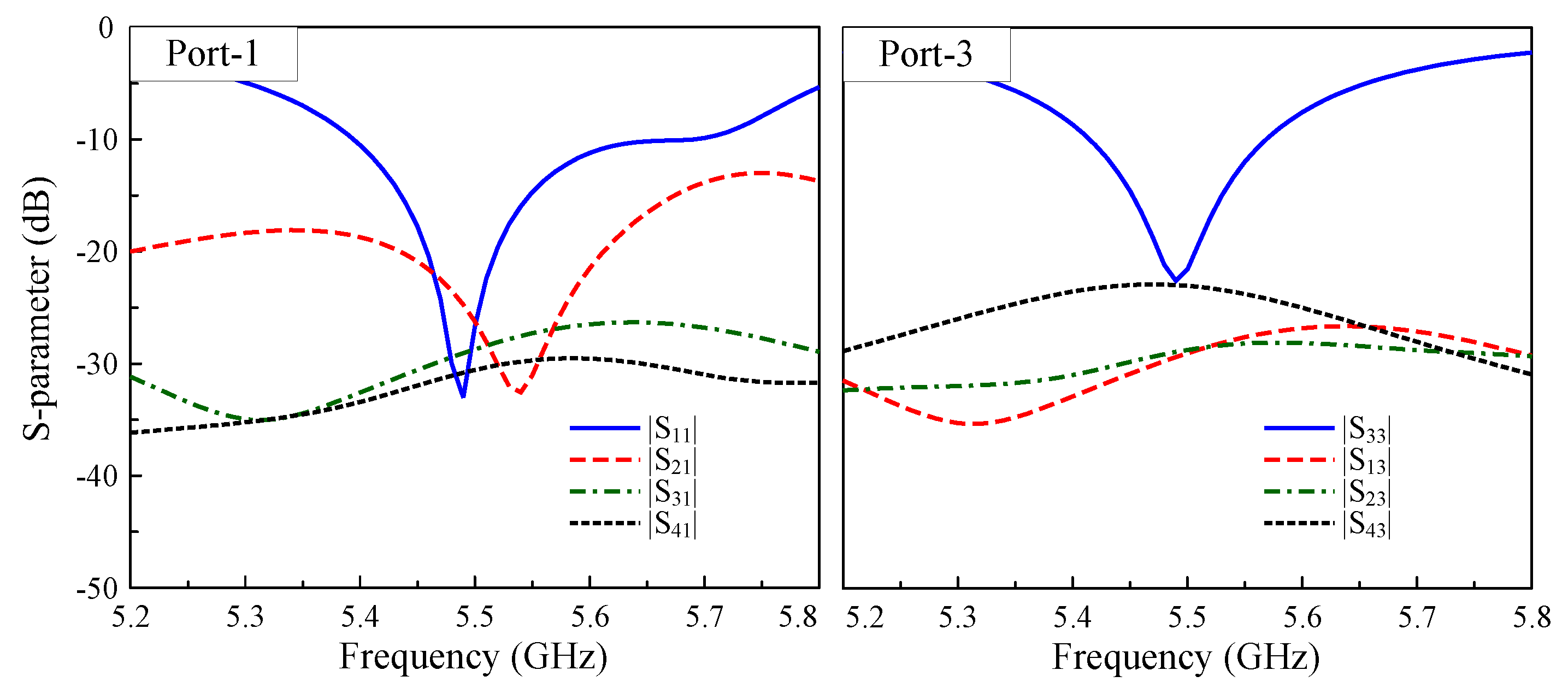



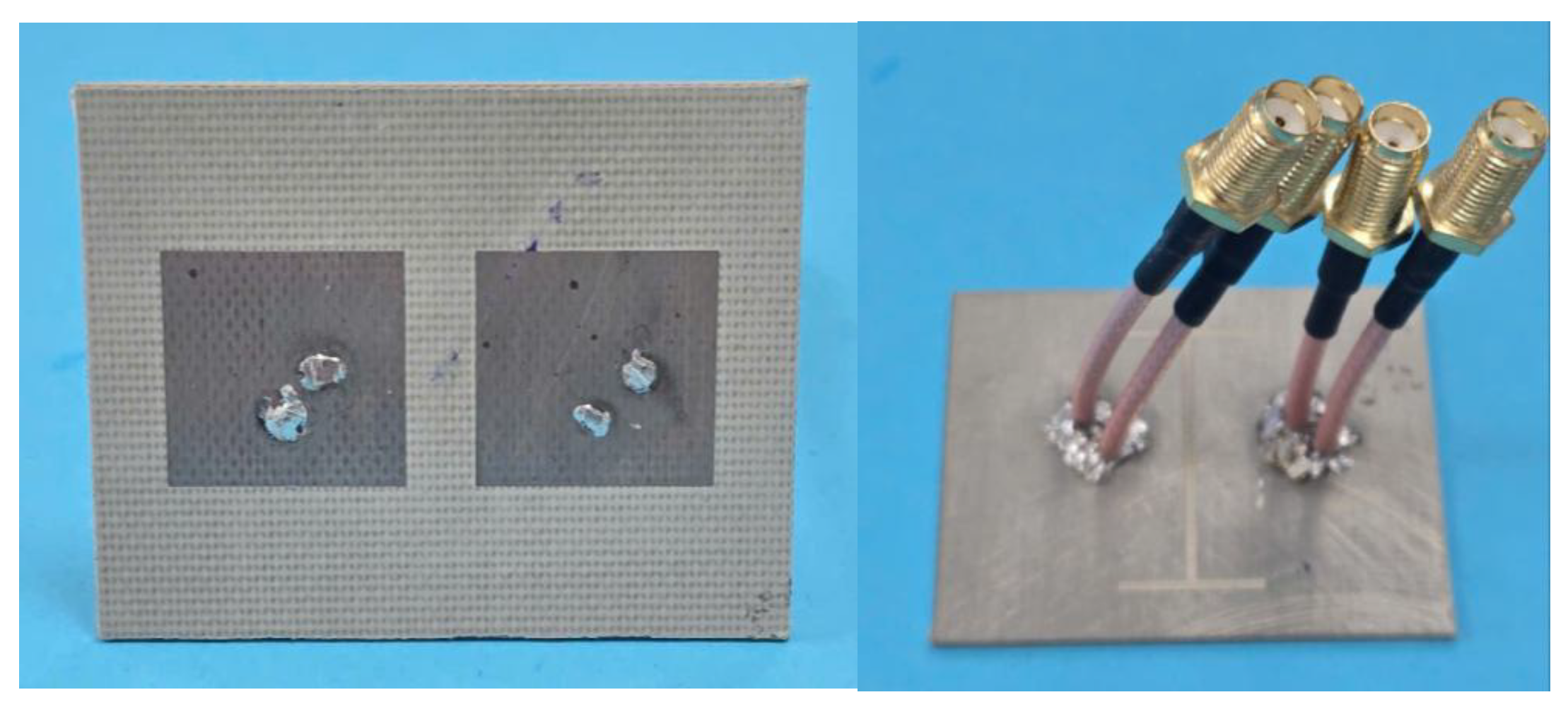
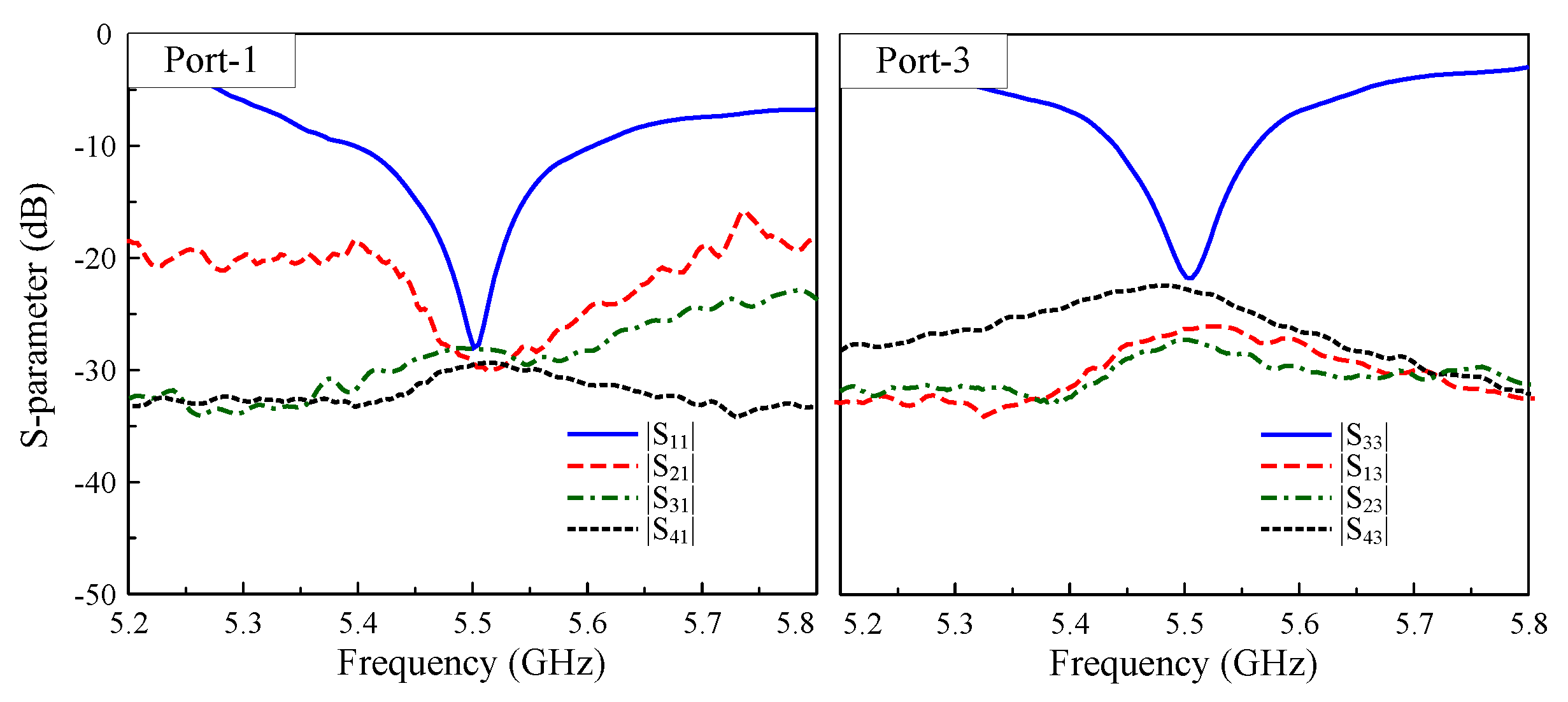
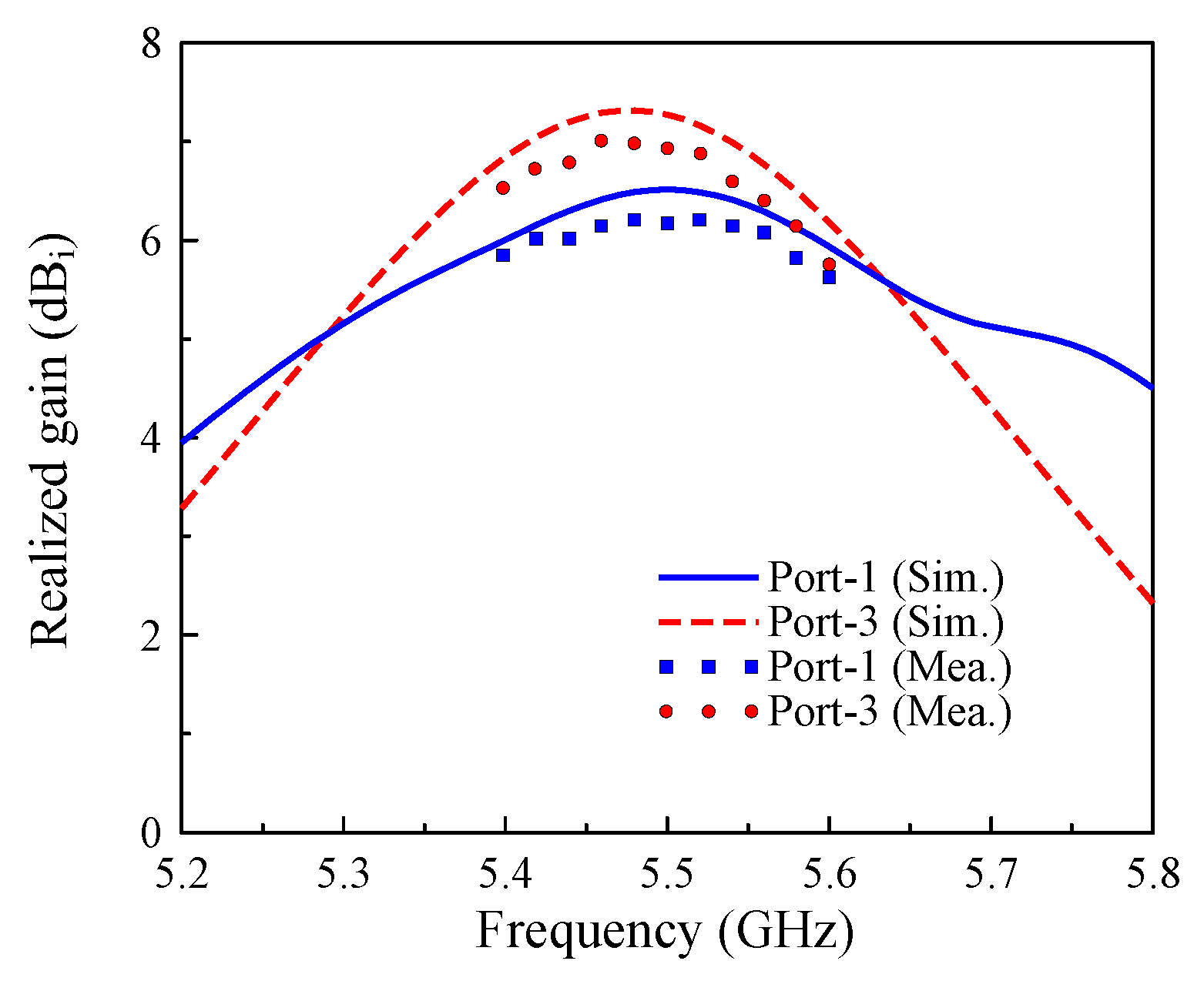

| Ref. | Overall Dimensions () | Decoupling Scheme | MIMO Element | No. of Ports | No. of Layers | Spacing () | Isolation (dB) |
|---|---|---|---|---|---|---|---|
| [12] | 1.26 × 0.84 × 0.02 | Extra coupling path | Single-pol. | 2 | 1 | 0.4 | ≥15 |
| [13] | 0.88 × 0.58 × 0.03 | Extra coupling path | Single-pol. | 2 | 1 | 0.3 | ≥20 |
| [16] | 1.07 × 0.55 × 0.02 | Band-stop filter | Dual-pol. | 4 | 2 | 0.42 | ≥10 |
| [17] | 1.03 × 0.52 × 0.10 | Extra coupling path | Dual-pol. | 4 | 2 | 0.51 | ≥15 |
| [18] | 1.38 × 0.69 × 0.10 | Cavity for field blocking | Dual-pol. | 4 | 2 | 0.53 | ≥20 |
| [19] | 1.47 × 1.74 × 0.05 | Matching network | Dual-pol. | 4 | 1 | 0.5 | ≥15 |
| Prop. | 0.92 × 0.73 × 0.03 | Band-stop filter | Dual-pol. | 4 | 1 | 0.4 | ≥20 |
Disclaimer/Publisher’s Note: The statements, opinions and data contained in all publications are solely those of the individual author(s) and contributor(s) and not of MDPI and/or the editor(s). MDPI and/or the editor(s) disclaim responsibility for any injury to people or property resulting from any ideas, methods, instructions or products referred to in the content. |
© 2025 by the authors. Licensee MDPI, Basel, Switzerland. This article is an open access article distributed under the terms and conditions of the Creative Commons Attribution (CC BY) license (https://creativecommons.org/licenses/by/4.0/).
Share and Cite
Tran-Huy, D.; Do-Manh, C.; Pham-Duy, H.; Tran-Viet-Duc, N.; Tran, H.; Nguyen-Tien, D.; Hussain, N. Compact Four-Port MIMO Antenna Using Dual-Polarized Patch and Defected Ground Structure for IoT Devices. Sensors 2025, 25, 4254. https://doi.org/10.3390/s25144254
Tran-Huy D, Do-Manh C, Pham-Duy H, Tran-Viet-Duc N, Tran H, Nguyen-Tien D, Hussain N. Compact Four-Port MIMO Antenna Using Dual-Polarized Patch and Defected Ground Structure for IoT Devices. Sensors. 2025; 25(14):4254. https://doi.org/10.3390/s25144254
Chicago/Turabian StyleTran-Huy, Dat, Cuong Do-Manh, Hung Pham-Duy, Nguyen Tran-Viet-Duc, Hung Tran, Dat Nguyen-Tien, and Niamat Hussain. 2025. "Compact Four-Port MIMO Antenna Using Dual-Polarized Patch and Defected Ground Structure for IoT Devices" Sensors 25, no. 14: 4254. https://doi.org/10.3390/s25144254
APA StyleTran-Huy, D., Do-Manh, C., Pham-Duy, H., Tran-Viet-Duc, N., Tran, H., Nguyen-Tien, D., & Hussain, N. (2025). Compact Four-Port MIMO Antenna Using Dual-Polarized Patch and Defected Ground Structure for IoT Devices. Sensors, 25(14), 4254. https://doi.org/10.3390/s25144254






